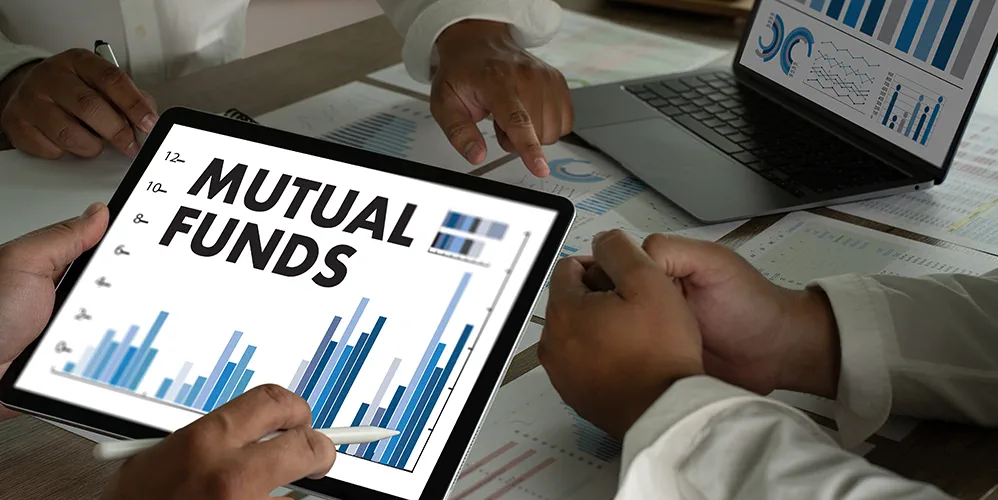
Analyzing Mutual Fund Performance
06 Sep 2023

Table of Content
-
Parameters To Analyse Mutual Fund Performance
-
1. Analyse Fund Performance vs Benchmark Performance
-
2. Check the Expense Ratio of Funds
-
3. Study Fund History
-
4. Check the Strength of the Portfolio
-
5. Check Portfolio Turnover Ratio (PTR)
-
6. Compare The Maturity Period of Funds
-
7. Compare Risk-Adjusted Returns
-
The Bottom Line
Investing in mutual funds is a popular choice for individuals seeking a diversified and professionally managed investment portfolio. Whether you are a seasoned investor or a novice, assessing the performance of your mutual funds is a critical aspect of successful investment management. By analysing the performance of your mutual funds, you can gain valuable insights into the effectiveness of your investment strategy and make informed decisions for your financial future.
This guide aims to provide a professional, crisp, and detailed overview of how to analyse your mutual fund performance effectively. We will explore the key metrics, methodologies, and considerations necessary to evaluate your mutual funds accurately. By understanding the concepts presented here, you will be equipped with the knowledge and tools to objectively assess your mutual fund performance and make informed investment decisions.
Parameters To Analyse Mutual Fund Performance
Analysing mutual fund performance is a critical aspect of investment management. By assessing various parameters, investors can gain valuable insights into the strengths, weaknesses, and overall suitability of their mutual fund investments. This section highlights key parameters to consider when analysing mutual fund performance. By understanding and evaluating these parameters, investors can make informed decisions to optimise their investment outcomes.
1. Analyse Fund Performance vs Benchmark Performance
Comparing the performance of your mutual fund against an appropriate benchmark is crucial to evaluate its relative performance. A benchmark is a standard index or a group of securities representing the market or a specific sector. By comparing your fund's returns to its benchmark, you can determine whether it has outperformed or underperformed in the market.
To perform this analysis, examine the fund's total returns over different time periods (one year, three years, five years, or since inception) and compare them to the returns of the benchmark over the same periods. Look for consistent outperformance or underperformance over multiple time frames to get a clearer picture of the fund's performance relative to the benchmark.
2. Check the Expense Ratio of Funds
The expense ratio is a vital parameter to consider when analysing mutual fund performance. It represents the annual fees and expenses charged by the fund company for managing the fund. A higher expense ratio can significantly impact investment returns over the long term.
When evaluating the expense ratio of a mutual fund, it is important to compare it with similar funds in its category. Lower expense ratios are generally preferred as they leave more of the fund's returns available to investors. However, it is crucial to consider other factors alongside the expense ratio.
Here are some key considerations related to the expense ratio:
Fund Size: Larger funds often benefit from economies of scale, which can result in lower expense ratios. However, very large funds might face challenges in maintaining their expense ratios if their asset base does not grow proportionally.
Investment Strategy: Certain investment strategies, such as actively managed funds or funds focused on niche sectors, tend to have higher expense ratios due to the costs associated with research, analysis, and trading. Passive index funds generally have lower expense ratios as they aim to replicate the performance of a specific market index.
Performance: While a lower expense ratio is desirable, it should not be the sole determinant of fund selection. It is essential to consider the fund's historical performance relative to its expense ratio. If a fund consistently delivers superior returns despite a slightly higher expense ratio, it may still be a viable option.
3. Study Fund History
Examining the historical performance of a mutual fund provides insights into its consistency, volatility, and ability to generate returns over different market cycles. Consider the following aspects of fund history:
Performance during different market conditions: Analyse how the fund has performed during both bull and bear markets. A fund that demonstrates resilience during market downturns and captures a significant portion of market upswings may be preferable.
Managerial changes and tenure: Evaluate any changes in the fund's management team or fund manager. A stable and experienced management team often instills confidence in investors. Assess the tenure of the current fund manager and their track record to determine their ability to deliver results consistently.
Fund objectives and strategy alignment: Understand the fund's investment objectives and strategy. Ensure that the fund's historical performance aligns with its stated objectives. A fund that consistently deviates from its stated strategy may not be suitable for your investment goals.
Also Read - Different Types of Mutual Fund Schemes in India
4. Check the Strength of the Portfolio
Assessing the strength of a mutual fund's portfolio is crucial in analysing its performance. Here are some key factors to consider:
Asset allocation: Examine the fund's allocation across different asset classes such as stocks, bonds, cash, and alternative investments. A well-diversified portfolio can help manage risk and potentially enhance returns. Ensure the fund's asset allocation aligns with your investment goals and risk tolerance.
Sector and industry exposure: Evaluate mutual funds holdings to determine their exposure to various sectors and industries. A balanced allocation across sectors can help mitigate concentration risk. Assess whether the fund's sector exposure aligns with your investment objectives and reflects your views on different industries.
Quality of holdings: Evaluate the quality of the individual securities held by the fund. Look for strong companies with solid financials, competitive advantages, and growth potential. Assess the fund's holdings based on factors such as market capitalisation, credit ratings (for fixed income securities), and the fund manager's investment thesis.
5. Check Portfolio Turnover Ratio (PTR)
The portfolio turnover ratio measures the frequency with which a mutual fund buys and sells securities within its portfolio. A high turnover ratio may indicate that the fund manager is actively trading and making frequent changes to the portfolio.
Evaluate the fund's turnover ratio relative to its peers and its investment strategy. A higher turnover ratio can lead to increased transaction costs and tax implications, which may impact returns. However, some fund strategies, such as active management or tactical asset allocation, may justify a higher turnover ratio. Consider whether the fund's turnover ratio aligns with your investment preferences and objectives.
Also Read - How to Invest in Mutual Funds: Explained in Easy Ways
6. Compare The Maturity Period of Funds
When investing in mutual funds, it is essential to consider the maturity period of the fund's holdings. The maturity period indicates the average time until the underlying bonds or fixed-income securities within the portfolio reach their maturity date.
Here are key points to consider when comparing the maturity period of funds:
Yield Curve Sensitivity: The maturity period affects a bond fund's sensitivity to changes in interest rates. Longer maturity periods typically result in higher interest rate risk. Bond prices tend to fall when interest rates rise, potentially impacting the fund's returns. Conversely, shorter maturity periods may offer lower yields but are less affected by interest rate changes.
Investment Horizon and Risk Tolerance: Consider your investment horizon and risk tolerance when evaluating the maturity period. If you have a shorter investment horizon or a lower tolerance for volatility, funds with shorter maturity periods may be more suitable. Conversely, if you have a longer investment horizon and can tolerate higher fluctuations, funds with longer maturity periods may offer higher potential returns.
Yield and Income Generation: Longer maturity periods often provide higher yields and income potential, as they include bonds with higher coupon rates. However, it is important to assess the credit quality and diversification of the underlying bonds to mitigate default risk.
Market Conditions and Economic Outlook: When comparing maturity periods, evaluate the prevailing market conditions and economic outlook. For instance, in a rising interest rate environment, shorter maturity funds may be more appealing as they are less impacted by interest rate fluctuations.
7. Compare Risk-Adjusted Returns
While evaluating mutual fund performance, it is crucial to assess risk-adjusted returns, which consider the level of risk taken to generate investment returns. Some key metrics to consider include:
Standard deviation: This measures the volatility or fluctuation in a fund's returns over a specific period. A lower standard deviation indicates lower volatility and potentially lower risk.
Beta: Beta measures the sensitivity of a fund's returns to changes in the market. A beta of 1 indicates that the fund's returns move in line with the market, while a beta of less than 1 suggests lower volatility than the market, and a beta greater than 1 indicates higher volatility.
Sharpe ratio: The Sharpe ratio assesses a fund's risk-adjusted returns by considering both the returns generated and the level of risk taken. A higher Sharpe ratio indicates better risk-adjusted performance.
The Bottom Line
Analysing mutual fund performance is crucial for informed investment decisions. By comparing against benchmarks, checking expense ratios, studying fund history, analyse mutual fund portfolio strength, examining turnover ratios, comparing maturity periods, and evaluating risk-adjusted returns, you can gain valuable insights into your investments. Make informed choices aligned with your goals and risk tolerance for optimal investment outcomes.
Popular Articles
-
Disclaimer
The contents of this article/infographic/picture/video are meant solely for information purposes and do not necessarily reflect the views of Bank of Baroda. The contents are generic in nature and for informational purposes only. It is not a substitute for specific advice in your own circumstances. Bank of Baroda and/ or its Affiliates and its subsidiaries make no representation as to the accuracy; completeness or reliability of any information contained herein or otherwise provided and hereby disclaim any liability with regard to the same. The information is subject to updation, completion, revision, verification and amendment and the same may change materially. The information is not intended for distribution or use by any person in any jurisdiction where such distribution or use would be contrary to law or regulation or would subject Bank of Baroda or its affiliates to any licensing or registration requirements. Bank of Baroda shall not be responsible for any direct/indirect loss or liability incurred by the reader for taking any financial decisions based on the contents and information mentioned. Please consult your financial advisor before making any financial decision.





